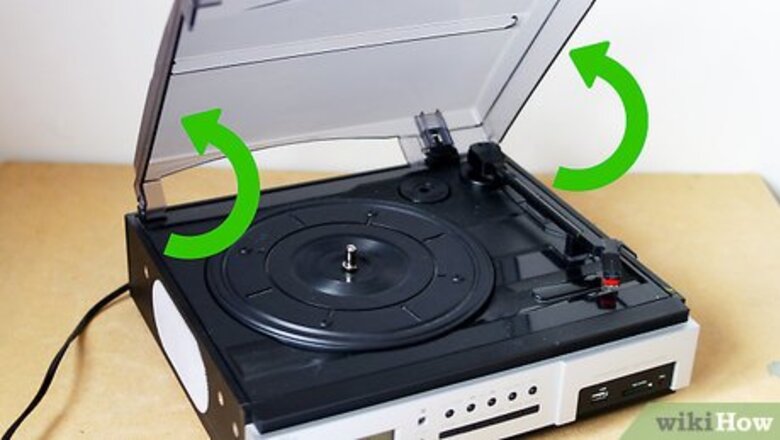
views
Preparing the Player and Handling Your Records
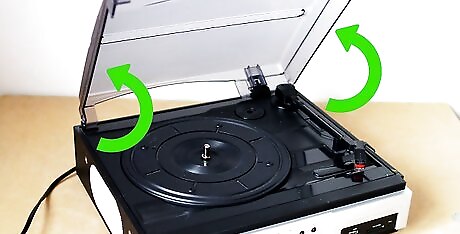
Lift the dust cover from the turntable. Turntables are usually fitted with plastic dust covers to keep the components clean when not in use. If you have a hinged dust cover, you can lift the cover and then gently lower it again once the record is playing. If your cover is not hinged, you should set it aside until you are done using the turntable. Placing it down while a record is playing can damage the player and record.
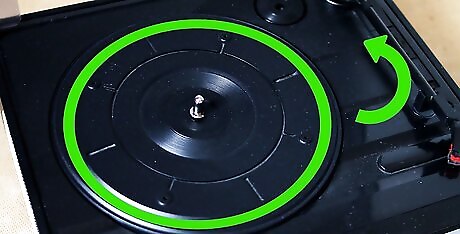
Remove the dust cover from the platter. The platter is the circular platform which you will place your vinyl record on. Sometimes there is a second dust cover, usually made of felt, that rests over the platter. Lift the circular felt cover off the platter and place it somewhere where it won’t attract much dust. You can store the felt cover inside of the record’s jacket while your record is playing. Though you may have a plastic cover, it is always good to use both when not using your turntable. Using both will ensure no dust or scratches occur and damage any components.
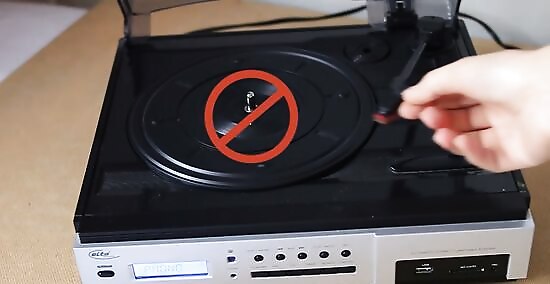
Make sure the turntable is not spinning. Some turntables will have a switch to start the rotation of the platter. Others will automatically start when the needle drops. In either case, make sure your record player isn’t spinning and the needle is up. If you place your vinyl record onto the platter while it is spinning you risk scratching the record.
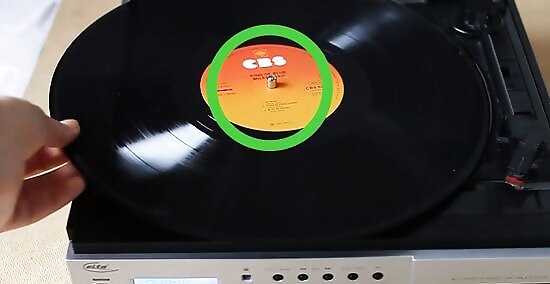
Place the record on the platter. Again, the platter is the round platform on which the vinyl record rests during play. Holding the record only along the record’s edges, lower the record onto the platter. Place the spindle in the center of the platter through the hole in the record. Lower the record until it is resting flush on the platter. Always hold your records by the edges and don’t touch the grooves of the record. When removing a record from the jacket, you may have to briefly grab the playing surface. Only touch the very outer portion where the grooves are not present to pull it out. Quickly transfer your grip to along the edges. The oil from your fingers can get onto the surface of the record and affect the sound as well as attract dust and cause scratches. The platter on most turntables will be made from metal, but should be fitted on top with a foam or rubber mat. This mat cushions the record during use, and you should never operate a turntable without a mat in place.
Operating the Turntable
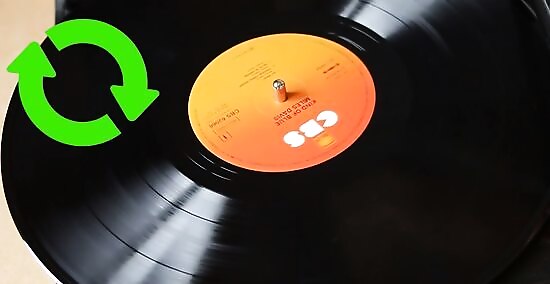
Put the platter into motion. Control setups will vary between turntables. But, most will have a switch that allows you to engage or disengage the motor driving the platter. In some cases, this switch will be integrated with the speed selector; for example, the 3 switch positions may be "off," "33 rpm," and "45 rpm." In other cases, you may need to select the speed using a separate switch or by repositioning the drive belt manually. Standard 12 inches (300 mm) records should play at “33 rpm.” On automatic turntables, the platter may be designed to start rotating when the tonearm is lifted towards the platter. In this case, you will not need to deliberately put the platter into motion.
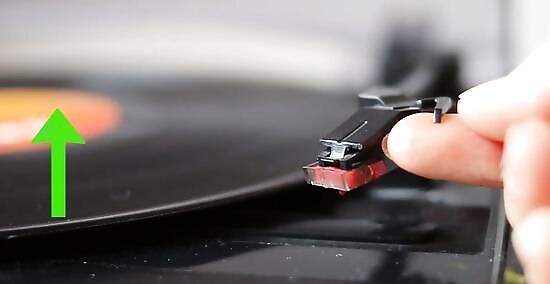
Lift or cue the tonearm. Many turntables will have a cueing feature that allows you to simply engage a switch that lifts the tonearm from its rest automatically. This process is called "cueing." Some turntable will have a cue lever which is used to raise and lower the arm. If you don't have a cue switch, gently lift the tonearm from its rest by placing your finger underneath the handle on the head shell. Or use the cue lever. Ensure that the cueing lever (if there is no switch), a small arm usually located at the base of your tonearm, is up. The cueing lever is what lowers and raises the tonearm. You need the cueing switch or arm to be up so that your tonearm doesn’t fall onto the vinyl when you move it from the resting position and over your record.
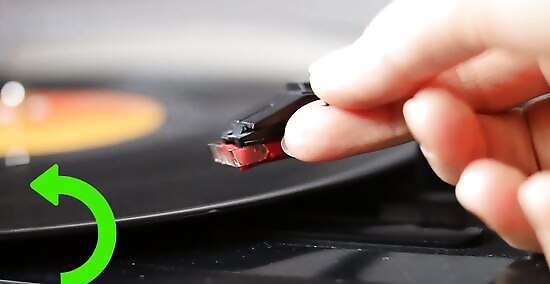
Position the tonearm above the beginning of the record. The needle of the tonearm needs to be positioned directly over the outermost grooves in the record. You should see a few widely spaced grooves on the outer perimeter that indicate the area before the recording begins. If your turntable has a cueing feature, you can gently push the tonearm into place with your fingers. It will rest above the record until you disengage the cueing switch or lever. If your turntable has no cueing switch, you will move the tonearm over the record by using the handle on the head shell.
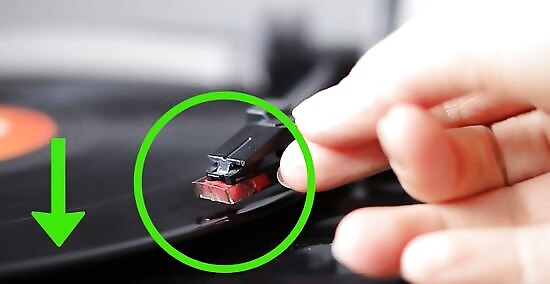
Lower the stylus onto the record. The tonearm should be lowered very gently onto the outer grooves of the vinyl record. The stylus should engage the grooves with minimal popping or clicking sounds. The recording should begin shortly after the stylus is lowered. To lower the tonearm using a cueing lever, simply disengage the switch or lever by lowering it down. The tonearm will gently lower itself and the stylus will engage the record’s grooves. To raise the tonearm, raise the cueing switch. Without a cueing switch, you will have to manually lower the tonearm onto the record. Be as slow and steady as possible when doing this. Lowering the stylus too violently can damage both the stylus and the record.
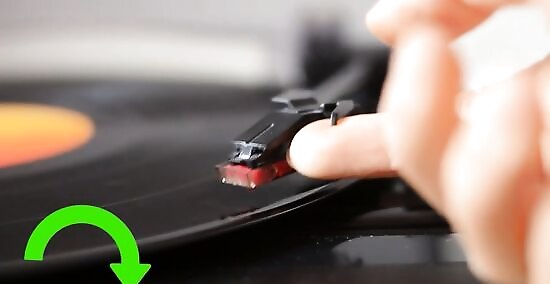
Put the tonearm back into place when the record is over. When you are done listening to the record, you need to lift the tonearm from the record and place it back into its resting position. Lifting the tonearm can either be done by engaging the cueing switch or by manually and gently lifting it from the record's surface. On some fully automatic turntables, the tonearm will return to place automatically once the record is over. Make sure that the tonearm is back in resting position before stopping the platter from spinning. The tonearm shouldn’t be resting on a stopped record. This could apply excess pressure to the grooves and cause damage. To listen to the other side of the record, flip it over and repeat the above process. When done using the turntable, remember to replace the dust cover. Make sure the tonearm is in resting position and the platter isn’t turning. Then lift the record by the edges and flip it.
Maintaining Your Turntable and Hooking up Stereo Equipment
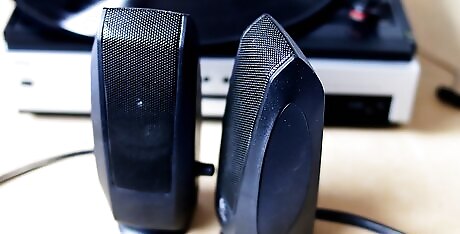
Get a receiver. A lot of record players require you to use a receiver to hook the turntable up to. The receiver then connects to speakers which will play the sound coming from the record. Hooking your turntable into a receiver and then connecting the receiver to speakers is the most common setup. If you already have a receiver and speakers for your home entertainment system, you can hook your turntable into your existing equipment. To get the sound from your turntable to come out of your speakers you will need to set your receiver on “Phono”. Some turntables will also require an external phono preamp to be hooked up. A preamp is used to help amplify the sound being created by the needle on the record’s grooves. Some receivers don’t have the necessary inputs required to effectively connect the turntable. However, many modern turntables have a built-in preamp that allows you to connect to your receiver.
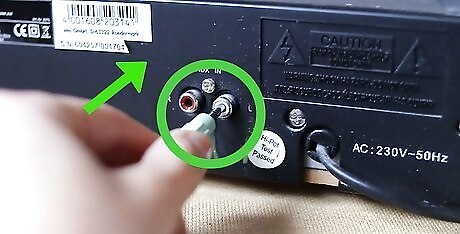
Attach all the cables. Attaching your cables correctly to your turntable and your receiver or speakers is fairly straight forward. There are often color coded cables to help you figure out where to put a certain cable. There isn’t only one way to attach all your cables as there are many different kinds of turntables and sound systems. Always keep your instruction manuals. Your instruction manuals for both your turntable and your sound equipment will guide you for your specific setup. When connecting all the cables make sure that your systems are turned off and unplugged. You don’t want to risk injury to getting shocked. Most turntables also have a small thin wire with a little crab claw-like metal tip. This wire is the “ground” wire. This wire prevents an unpleasant buzzing sound when playing. There will be a marked connection point on your stereo system, provided it can play phono.
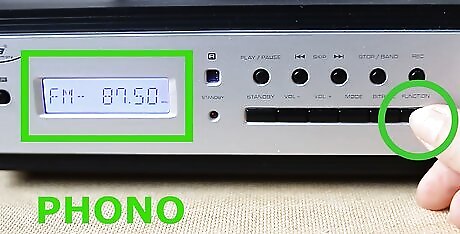
Switch to the correct input. Once it looks like your turntable and sound system is correctly hooked up, plug everything in and set your receiver to “Phono”. The phono input is the one you need for your record to be heard. Because the sound isn’t coming from a digital source like from an iPod or CD, it is much lower. The phono setting, along with a phono preamp, whether external or built-in, amplifies the sound.
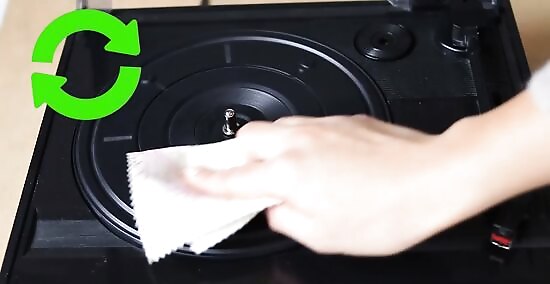
Keep dust off your turntable and needle. To prevent any scratching or muddled sounds, make sure that you always keep your needle free of dust. The small needle at the tip of your tonearm often collects dust very easily. If your needle has a dust cap, be sure to place it on after every use. If there is dust on your needle, you will need a stylus cleaning brush and turntable cleaning solution or rubbing alcohol. Dampen the stylus brush and gently wipe the styles from front to back.
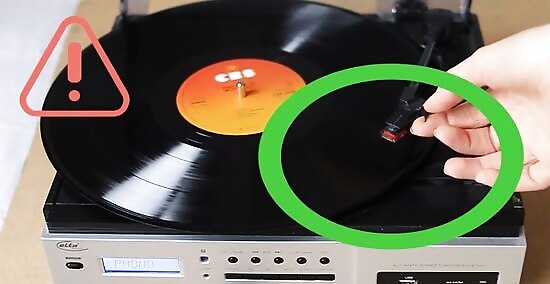
Operate your turntable correctly. Always take the necessary steps to operate your turntable and records correctly. Though it may take more time, it’s worth it to preserve your equipment. Always remove and replace any dust covers before and after each use. Don’t start spinning the platter before you place your record down. Likewise, always wait for the platter to completely stop before removing your vinyl otherwise you may scratch it. Operate your tonearm and needle correctly. Never drop or abruptly remove the needle. Always use the cueing arm. Don’t get your fingerprints on the surface of the records. Always hold by the edges. Store records vertically in a dry location. Humidity and stacking records on top one another will cause records to warp. Always put a record away as soon as you are done listening.



















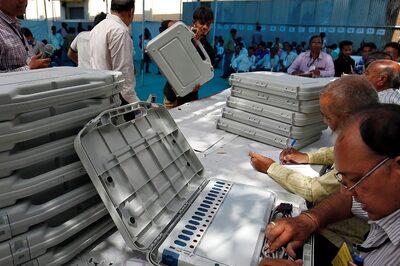
Comments
0 comment